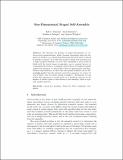One-dimensional staged self-assembly
Author(s)
Demaine, Erik D.; Eisenstat, Sarah Charmian; Ishaque, Mashhood; Winslow, Andrew
DownloadDemaine-One-dimensional.pdf (232.3Kb)
OPEN_ACCESS_POLICY
Open Access Policy
Creative Commons Attribution-Noncommercial-Share Alike
Terms of use
Metadata
Show full item recordAbstract
We introduce the problem of staged self-assembly of one-dimensional nanostructures, which becomes interesting when the elements are labeled (e.g., representing functional units that must be placed at specific locations). In a restricted model in which each operation has a single terminal assembly, we prove that assembling a given string of labels with the fewest stages is equivalent, up to constant factors, to compressing the string to be uniquely derived from the smallest possible context-free grammar (a well-studied O(logn)-approximable problem). Without this restriction, we show that the optimal assembly can be substantially smaller than the optimal context-free grammar, by a factor of Ω √n/log n even for binary strings of length n. Fortunately, we can bound this separation in model power by a quadratic function in the number of distinct glues or tiles allowed in the assembly, which is typically small in practice.
Description
17th International Conference, DNA 17, Pasadena, CA, USA, September 19-23, 2011. Proceedings
Date issued
2011-09Department
Massachusetts Institute of Technology. Computer Science and Artificial Intelligence Laboratory; Massachusetts Institute of Technology. Department of Electrical Engineering and Computer ScienceJournal
DNA Computing and Molecular Programming
Publisher
Springer Berlin / Heidelberg
Citation
Demaine, Erik D. et al. “One-Dimensional Staged Self-assembly.” DNA Computing and Molecular Programming. Ed. Luca Cardelli & William Shih. LNCS Vol. 6937. Berlin, Heidelberg: Springer Berlin Heidelberg, 2011. 100–114.
Version: Author's final manuscript
ISBN
978-3-642-23637-2
ISSN
0302-9743
1611-3349